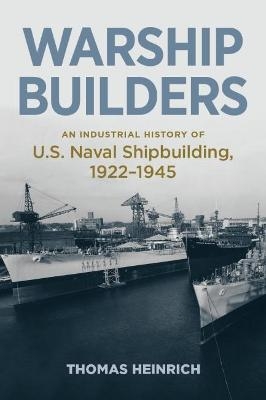
Warship Builders
An Industrial History of U.S. Naval Shipbuilding, 1922-1945
Seiten
2020
Naval Institute Press (Verlag)
978-1-68247-537-9 (ISBN)
Naval Institute Press (Verlag)
978-1-68247-537-9 (ISBN)
Provides the first scholarly study of the US naval shipbuilding industry from the early 1920s to the end of World War II, when American shipyards produced the world's largest fleet that helped defeat the Axis powers in all corners of the globe.
Warship Builders is the first scholarly study of the U.S. naval shipbuilding industry from the early 1920s to the end of World War II, when American shipyards produced the world's largest fleet that helped defeat the Axis powers in all corners of the globe. A colossal endeavor that absorbed billions and employed virtual armies of skilled workers, naval construction mobilized the nation's leading industrial enterprises in the shipbuilding, engineering, and steel industries to deliver warships whose technical complexity dwarfed that of any other weapons platform. Based on systematic comparisons with British, Japanese, and German naval construction, Thomas Heinrich pinpoints the distinct features of American shipbuilding methods, technology development, and management practices that enabled U.S. yards to vastly outproduce their foreign counterparts.
Throughout the book, comparative analyses reveal differences and similarities in American, British, Japanese, and German naval construction. Heinrich shows that U.S. and German shipyards introduced electric arc welding and prefabrication methods to a far greater extent than their British and Japanese counterparts between the wars, laying the groundwork for their impressive production records in World War II. While the American and Japanese navies relied heavily on government-owned navy yards, the British and German navies had most of their combatants built in corporately-owned yards, contradicting the widespread notion that only U.S. industrial mobilization depended on private enterprise. Lastly, the U.S. government's investments into shipbuilding facilities in both private and government-owned shipyards dwarfed the sums British, Japanese, and German counterparts expended. This enabled American builders to deliver a vast fleet that played a pivotal role in global naval combat.
Warship Builders is the first scholarly study of the U.S. naval shipbuilding industry from the early 1920s to the end of World War II, when American shipyards produced the world's largest fleet that helped defeat the Axis powers in all corners of the globe. A colossal endeavor that absorbed billions and employed virtual armies of skilled workers, naval construction mobilized the nation's leading industrial enterprises in the shipbuilding, engineering, and steel industries to deliver warships whose technical complexity dwarfed that of any other weapons platform. Based on systematic comparisons with British, Japanese, and German naval construction, Thomas Heinrich pinpoints the distinct features of American shipbuilding methods, technology development, and management practices that enabled U.S. yards to vastly outproduce their foreign counterparts.
Throughout the book, comparative analyses reveal differences and similarities in American, British, Japanese, and German naval construction. Heinrich shows that U.S. and German shipyards introduced electric arc welding and prefabrication methods to a far greater extent than their British and Japanese counterparts between the wars, laying the groundwork for their impressive production records in World War II. While the American and Japanese navies relied heavily on government-owned navy yards, the British and German navies had most of their combatants built in corporately-owned yards, contradicting the widespread notion that only U.S. industrial mobilization depended on private enterprise. Lastly, the U.S. government's investments into shipbuilding facilities in both private and government-owned shipyards dwarfed the sums British, Japanese, and German counterparts expended. This enabled American builders to deliver a vast fleet that played a pivotal role in global naval combat.
Thomas Heinrich is professor of U.S. business and naval history at Baruch College, City University of New York. Born and raised in Germany, he received his PhD degree from the University of Pennsylvania and is the author of Ships for the Seven Seas: Philadelphia Shipbuilding in the Age of Industrial Capitalism and Kimberly-Clark and the Consumer Revolution in American Business.
| Erscheinungsdatum | 22.01.2021 |
|---|---|
| Zusatzinfo | Illustrations |
| Verlagsort | Annopolis |
| Sprache | englisch |
| Maße | 152 x 228 mm |
| Gewicht | 576 g |
| Themenwelt | Sachbuch/Ratgeber ► Geschichte / Politik ► Allgemeines / Lexika |
| Geschichte ► Allgemeine Geschichte ► 1918 bis 1945 | |
| Geschichte ► Teilgebiete der Geschichte ► Militärgeschichte | |
| Geschichte ► Teilgebiete der Geschichte ► Wirtschaftsgeschichte | |
| ISBN-10 | 1-68247-537-9 / 1682475379 |
| ISBN-13 | 978-1-68247-537-9 / 9781682475379 |
| Zustand | Neuware |
| Informationen gemäß Produktsicherheitsverordnung (GPSR) | |
| Haben Sie eine Frage zum Produkt? |
Mehr entdecken
aus dem Bereich
aus dem Bereich
ein Psychologe erlebt das Konzentrationslager
Buch | Hardcover (2024)
Kösel (Verlag)
22,00 €
Belzec, Sobibór, Treblinka und die Aktion Reinhardt
Buch | Softcover (2023)
C.H.Beck (Verlag)
16,00 €


